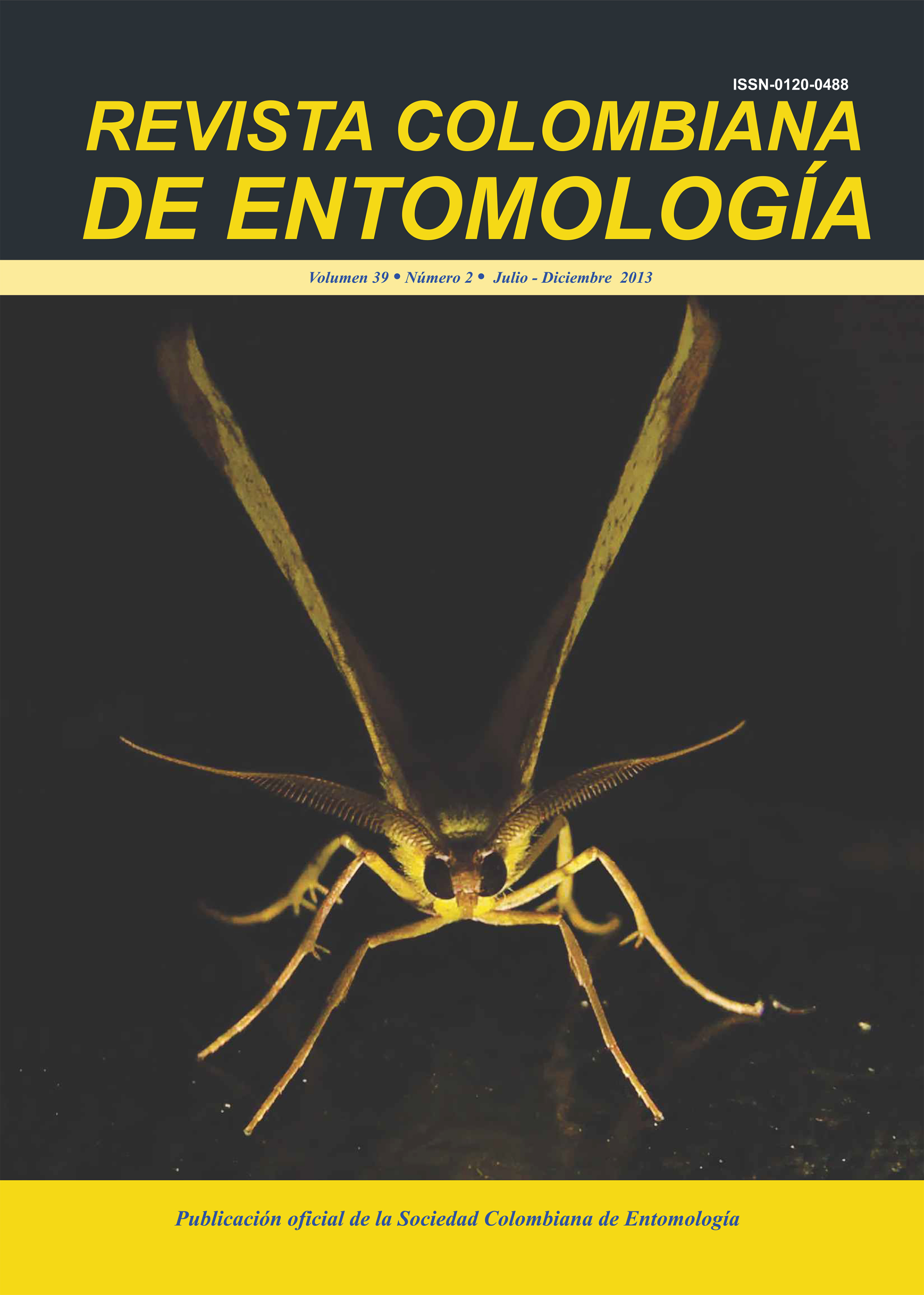Population fluctuation of Diaphorina citri (Hemiptera: Liviidae) in Persian lime (Citrus latifolia), in Huimanguillo Tabasco, Mexico
Main Article Content
Diaphorina citri is the vector of Huanglongbing disease, which is currently in 12 of 23 citrus producing states in Mexico, including Tabasco, where there are 15,406 ha of these crops. The aim of this study was to determine the population dynamics of D. citri and its relation with the abundance of vegetative shoots, temperature and precipitation in Huimanguillo, Tabasco. The work was done by sampling fortnightly from September 2010 to August 2011 in a plantation of Persian lime (Citrus latifolia Tanaka) of 1 ha. Population dynamics of eggs and nymphs was determined by collecting vegetative shoots, and adult dynamics by capturing them in yellow sticky traps. The highest incidence of D. citri was between March and June, coinciding with the abundance of vegetative shoots and high temperature. The abundance of eggs and nymphs showed high correlation with that of vegetative shoots, moderate correlation with temperature, and negative correlation with rainfall. The incidence of adults exhibited a moderately correlation with temperature and a low correlation with abundance of vegetative shoots and precipitation.
- Rutaceae
- Pest management
- Huanglongbing vector
ALEMÁN, J.; BAÑOS, H.; RAVELO, J. 2007. Diaphorina citri y la enfermedad Huanglongbing: una combinación destructiva para la producción citrícola. Revista de Protección Vegetal 22 (3): 154-165.
AUBERT, B. 1987. Le greening, une maladie infectieuse des agrumes, d’origine bactérienne, transmis par des homopteres psyllides. IRFA/CIRAD, St Pierre. 185 p.
BISQUERRA, R. 2004. Metodología de la Investigación Educativa. La Muralla, S.A., Madrid. 341 p.
BOVÉ, J. M. 2006. Huanglongbing: a destructive, newly-emerging, century-old disease of citrus. Journal of Plant Pathology 88: 7-37.
DÍAZ, C. 2010. Naranja dulce, limón partido. Revista Claridades Agropecuarias 197: 32-39.
HALL, D. G.; HENTZ, G. M.; ADAIR, C. R. 2008. Ecology and phenology of Diaphorina citri (Hemiptera: Psyllidae) in two Florida citrus groves. Environmental Entomology 37 (4): 914924.
HALBERT, S. E.; MANJUNATH, K. L. 2004. Asian citrus psyllids (Sternorrhyncha: Psyllidae) and greening disease of citrus: A li terature review and assessment of risk in Florida. Florida Entomologist 87 (3): 401-402.
LIU, Y. H.; TSAI, J. H. 2000. Effects of temperature on biology and life table parameters of the Asian citrus psyllid, Diaphorina citri Kuwayama (Homoptera: Psyllidae). Annals of Applied Biology 137: 201-206.
MORENO P., M.; POZO V., E.; VALDÉS H., R.; CÁRDENAS M., M. 2008. Distribución espacial de Diaphorina citri Kuwayama (Hemiptera: Psyllidae) sobre lima persa (Citrus lattifolia Tanaka). Fitosanidad 12 (1): 33-37.
NORRIS, R. F.; CASWELL-CHEN, E. P.; KOGAN, M. 2003. Concepts in integrated pest management. Prentice Hall. New Jersey, EE.UU, 586 p.
ORTEGAA., L. D.; VILLEGAS M., A.; RAMÍREZ R., A. J.; MENDOZA G., E. E. 2013. Abundancia estacional de Diaphorina citri (Hemiptera: Liviidae) en plantaciones de cítricos en Cazones, Veracruz, México. Acta Zoológica Mexicana (n.s.) 29 (2): 317-333.
QURESHI, J. A., ROGERS, M. E.; HALL, D. G.; STANSLY, P. A. 2009. Incidence of invasive Diaphorina citri (Hemiptera: Psyllidae) and its introduced parasitoid Tamarixia radiate (Hymenoptera: Eulophidae) in Florida citrus. Journal of Economic Entomology 102 (1): 247-256.
SÁEZ C., A. J. 2010. Métodos estadísticos con R y R Commander version 2.1. Universidad de Jaén, España. 153 p.
SENASICA. 2011. Servicio Nacional de Sanidad, Inocuidad y Calidad Agroalimentaria. 2011. Comunicados de la primera detección de HLB huanglongbing en México. Disponible en: http:// www.senasica.gob.mx/default.asp?doc=9361 [Fecha revisión: 15 junio 2012].
SENASICA. 2013. Servicio Nacional de Sanidad, Inocuidad y Calidad Agroalimentaria. 2013. Circular 021. Disponible en: http:// www.cesavep.org/descargas/Normatividad/29_circular%20021%20(of.-01406)%20estrategia%20PTA%20HLB%20y%20 PRC%202013.pdf [Fecha revisión: 13 septiembre 2013].
SIAP. 2010. Servicio de Información Agroalimentaria y Pesquera. 2010. Producción agrícola por cultivo y por estado. México. Disponible en: http://www.siap.gob.mx/index.php?option=com_ wrapper&view=wrapper&Itemid=350 [Fecha revisión: 1 octubre 2011].
TOLEDO, M. R.; ETCHEVERS, J. D. 1988. Estado nutricional de los cítricos de la Sabana de Huimanguillo, Tabasco. Terra 6 (2): 140-150.
TSAI, J. H.; WANG, J. J.; LIU, H. Y. 2002. Seasonal abundance of the Asian citrus psyllid, Diaphorina citri (Homoptera: Psyllidae) in Southern Florida. Florida Entomologist 85 (3): 446-451.
Downloads

This work is licensed under a Creative Commons Attribution-NonCommercial-ShareAlike 4.0 International License.
Authors retain the copyright on their work and are responsible for the ideas expressed in them. Once a manuscript is approved for publication, authors are asked for a publication license for the term of legal protection, for all territories that allows the use, dissemination and disclosure of the same.





